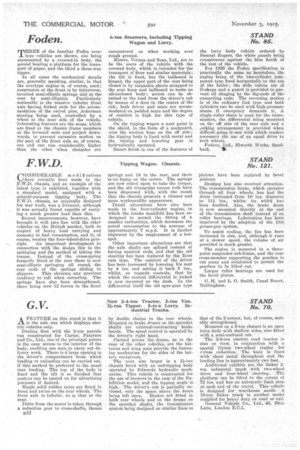F.W.D.
Page 18

If you've noticed an error in this article please click here to report it so we can fix it.
CONSIDERABLE modifi cations have recently been made in the F.W.D. chassis, and an example of the latest typeis exhibited, together with a standard model, equipped with a general-purpose tipping body. The F.W.D. chassis, as originally designed for war work, was a 3-tonner, although it was actually found capable of carrying a much greater load than this.
Recent improvements, however, have brought it well into line with the other vehicles on the British market, both in respect of heavy load carrying and economy in fuel consumption, and it, of course, retains the four-wheel-drive prin ciple. An important development in connection with the design lies in the springing and the method of taking the torque. Instead of the cross-spring formerly fitted at the rear there is now semi-elliptic springing all round, the rear ends of the springs sliding in slippers. This obviates any previous tendency to roll when cornering. The springs have also been strengthened, there being now 12 leaves in the front
springs and 14 in the rear, and there -is no 'lamp on the centre. The springs are now relied upon to take the torque, and the old triangular torque rods have been dispensed with, with the result that the chassis presents a cleaner and more workmanlike appearance.
Detail alterations have also been made in the four-cylinder engine, in which the intake manifold has been redesigned to permit the fitting of a smaller carburetter, which decreases the petrol consumption to the average of approximately 7 m.p.h. It is further improved by the employment of a hotspot.
Other important alterations are that the axle shafts are splined instead of having squared ends, and that the old steering has been replaced by the Ross cam type. The comfort of the driver has been increased by lowering his seat by 4 ins, and setting it back 5 ins., whilst, as regards controls, that by which the central differential is locked is now mounted on the dash. In the differential itself the old spur-gear type pinions have been replaced by bevel
Braking has also received attention. The transmission brake, which operates through all four, wheels, has had the drum increased from 10 ins. diameter, ta 111 ins., whilst its width has been doubled. Also, the brake drum is now mounted directly at the end of the transmission shaft instead of on roller bearings. Lubrication has been improved by the adoption of the Dot_ grease-gun system.
To assist cooling, the fan has been increased in size, and, although it runs at a slower speed, the volume of air provided is much greater.
The engine is mounted in a threepoint suspended sub-frame, and the rear cross-member supporting the gearbox is cut away and reinforced to permit the gearbox to be lifted out.
Larger roller bearings are used for the bevel pinion.
C. IL and L. 0. Smith, Canal Street, Nottingham.
















































































